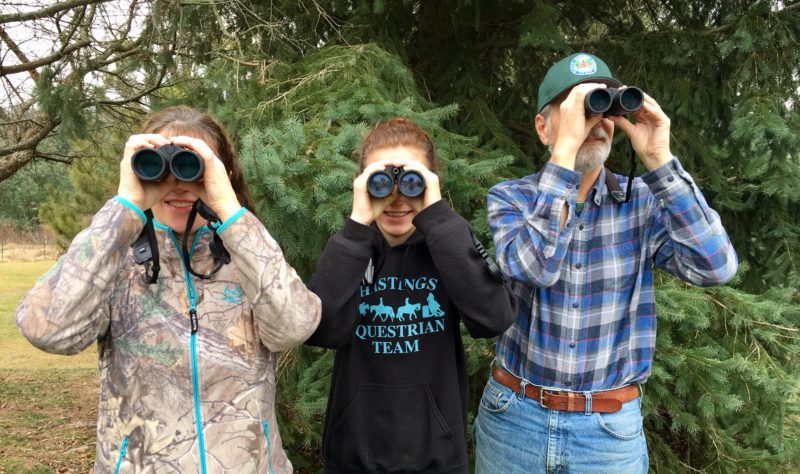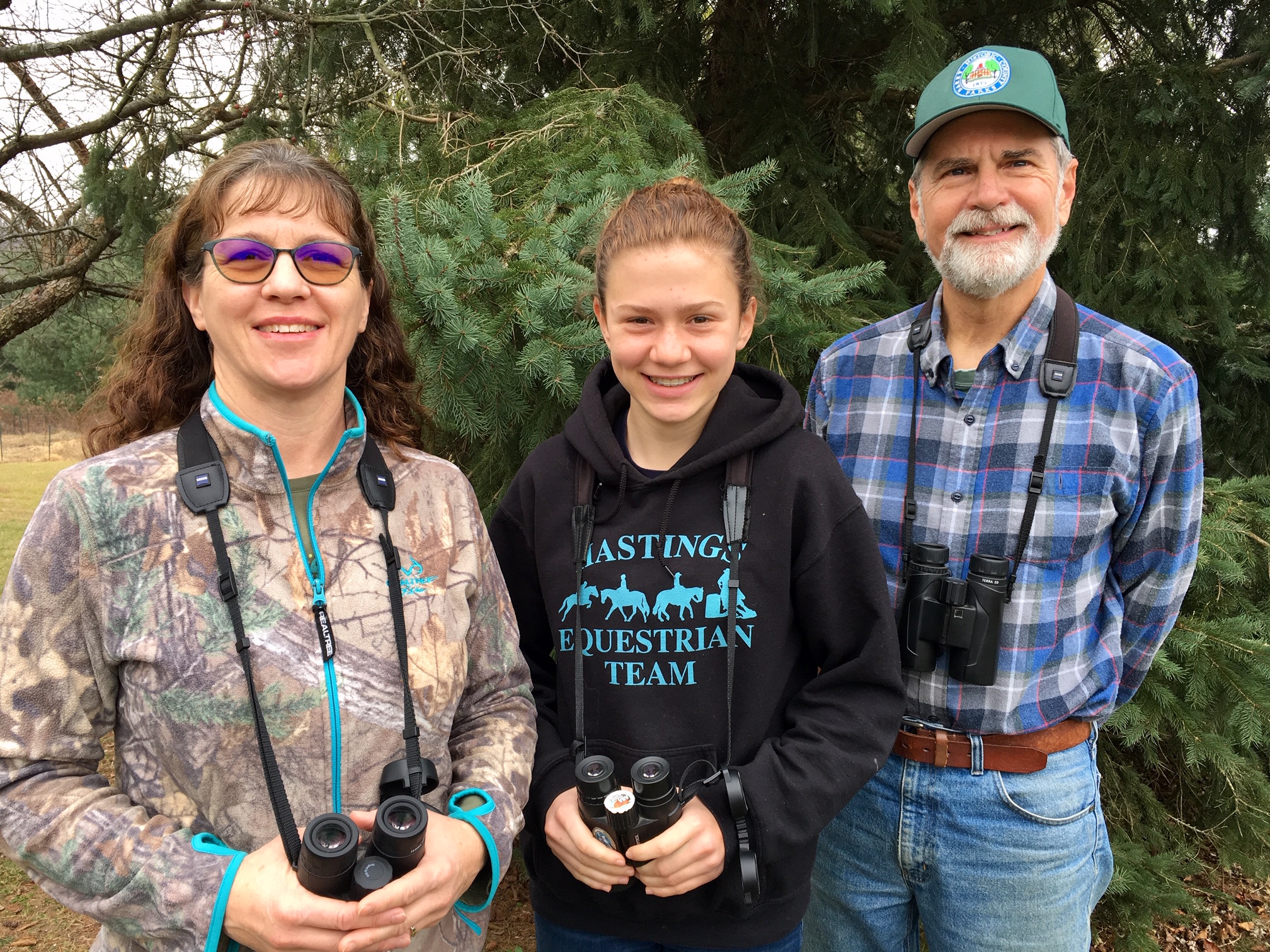Doug and Anne Klein, along with their daughter, Maeve, have been an active part of Michigan Audubon, sharing their love for birds through volunteering at our sanctuaries and events and even founding the Barry County Bird Club in their community.
How has birding played a role in your life?
Doug: Anne and I both grew up on the southeast side of Grand Rapids. We went to different schools, so we never met until a field trip with Grand Rapids Audubon Club in 1989. We were members of that club for decades until we moved to Hastings and the travel to meetings with young children got to be too much. We survived on feeder birding for many years until one fateful winter when we noticed we had a pair of Long-eared Owl roosting in our pines. We invited anyone and everyone to see this elusive owl, and through that venture, we met many birders from Barry County. We realized we had enough local people interested in birds that we could start a bird club in Hastings. Thus began the Barry County Bird Club in April 2014.
Maeve: I started birding in 2014 at the age of 8 and began leading Cerulean Warbler Weekend tours at 11. I also am active on iNaturalist and WhatBird helping with bird identification.
How do you contribute to the Barry County Bird Club?
Doug: We run the meetings, plus lead all of the field trips. That is all on hold for the time being. The club is supported by many loyal naturalists who provide us with ideas for interesting speakers. We now have over 200 people on our email list, and we have managed to keep our club dues-free.
Anne: I love leading field trips for the club, meeting new people, and introducing them to the joy and wonder of birds. Volunteering at Youth Day is especially fun since children are so enthusiastic. In 2019, I believe that more than 800 kids attended, not counting accompanying adults, so that is a substantial outreach. And it is nice to listen to people’s personal “bird story” when they share, whether it is a bird they saw in their yard or at a feeder, and provide feedback or answers to their bird questions. If the birding is slow, we explore other animals, insects, plants, etc. Barry County is so beautiful that we can always find some natural wonder to enjoy and appreciate on our outings.
The most gratifying thing for me about sharing birds with others is when someone looks through your spotting scope or their binoculars and sees a neat bird and says in awe, “Oh, wow!” Now you know you’ve reached them at a personal level.
Maeve: I am the IT help for the meetings and provide warbler ID help for field trips. I helped create the Barry County Bird Club Facebook group (new members are always welcome!) and I moderate our club email.
Ronald H. Warner Sanctuary is a special place for you. Can you share why that is and the projects you have worked on there as a volunteer?
Doug: I first visited Warner Sanctuary on a Grand Rapids Audubon field trip in 1974. I saw my lifer Red-bellied Woodpecker there. Warner Sanctuary has a mix of red pines and native hardwoods, plus a quiet lake and a couple of creeks that flow through the property. It is one of Barry County’s best-kept secrets — you can bird there all day and not run into another soul. As an eBird hotspot, over 118 species of birds have been seen there. It is probably the most reliable place in the county to hear Red-shouldered Hawk. In summer, the woods feature Veery, Ovenbird, Blue-winged and Pine Warblers, Pileated Woodpecker, Brown Creeper, American Redstart, and Acadian Flycatcher.
When I noticed a deterioration of the trails and human-made infrastructure, I decided to step in and apply my skills as a carpenter and woodcutter to make the sanctuary more user-friendly.
There are two boardwalks through wetlands on the lake border and creek floodplain that have been refurbished. The existing bridge over Glass Creek was straightened as well. A new trail was added to the west half of the property recently, along with two new bridges and two new benches for visitors to use. I also kept the trails free of deadfall trees and did some string-trimming a couple of times to knock back the ever-encroaching brush and invasives. I added a couple of signs for safety and trail navigation, plus lowered the existing informational kiosk to a more usable height. Last summer, we covered protruding roots in the parking area’s driveway with some much-needed gravel.
Maeve, as one of our youngest Cerulean Warbler Weekend guides, you’ve been an excellent addition to the Michigan Audubon community! How do you think we can better encourage young adults like you to get involved with bird conservation?
Maeve: Thank you! I think you need to first introduce young adults to birds and birding. Show them the beauty of the natural world — the excitement of seeing a male Blackburnian Warbler in the sun, the beauty of a carpet of blooming trillium, the majesty of a Short-eared Owl hunting over snow-covered fields. These experiences make you slow down and appreciate the moment. It is a worldwide scavenger hunt! Emphasize that all habitat conservation is important because the natural world is all interconnected. When I started birding, a big draw for me was putting our checklists into eBird — supporting conservation through citizen science! Media outreach is a big plus, too, and continuing to offer opportunities such as your Michigan Young Birders Camp.
What do you think is one of the most critical bird conservation issues right now?
Doug: I think getting a handle on climate change and arresting our carbon dioxide and methane emissions is crucial. To that end, we added a 10.5 KW photovoltaic solar array to our barn this past summer, and we are considering leasing an electric car.
Anne: Two things come to mind in bird conservation. First, introducing people to birds and birding and hopefully having them become interested in bird survival. I am sure you are familiar with the expression, “You won’t love what you don’t know.” Reaching out to the younger generation and planting the seeds early is also a good strategy.
Second, loss of habitat is another important bird conservation issue. We are disheartened when we see another local farm field being tiled for better drainage. This helps the farmer but doesn’t help migrating birds like shorebirds have places to feed during spring migration. It is also necessary to reduce the use of chemicals and pesticides, which can adversely affect beneficial insects, which feed birds. It is encouraging to see how frequently Bald Eagle are seen in Michigan since we got rid of DDT in the 1970s.
This article originally appeared in the 2021 Winter Jack Pine Warbler.

Additional questions for the online article
Has the COVID-19 pandemic impacted the way that you bird? How so? Has it affected the Barry County Bird Club community?
Doug: One COVID impact for me was keeping me away from the most crowded trails, such as the Paul Henry Trail in Middleville. It also killed my business travel, which meant no birding in new states or looking for potential life birds. We also avoid carpooling on birding trips for the time being.
Do you volunteer for other organizations?
Doug: Yes, I am a Commissioner on the Barry County Parks and Recreation Commission. I was a board member at Whitefish Point Bird Observatory nearly 30 years ago. We all help Otis Farm Bird Sanctuary Resident Manager Sarah Nelson with the Barry County Youth Day at Charlton Park. We also helped a local high school teacher who taught an outdoor education class. We gave presentations to the class on birding and also on backpacking.
Anne: We all volunteer at our church.
What was your involvement in organizing the Thornapple Birding Trail?
Doug: We noticed birding trails around the state and thought, “Why not Barry County?” Barry has many great birding areas and is easily accessible to birders in nearby cities such as Grand Rapids, Kalamazoo, Battle Creek, and Lansing. Anne and Maeve helped me design and proofread the trail’s printed brochures, as did Sarah Nelson. I leaned heavily upon Darrell Lawson of Boyne City, who had formed the Sunset Coast Birding Trail a few years ago. But the real heroes were the birders who donated money to help with printing and signs for the trail. We raised over $4,500 in support of the trail! The Barry County government IT staff provided website design, and the parks commission will also cover reprinting of the brochures as they are needed.

